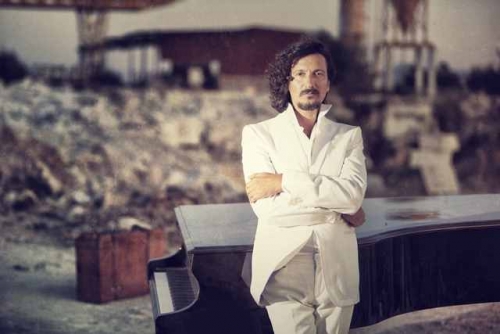The biggest names in the field of commercial mainstream popular music rarely feature artists in genres outside the areas of pop, country, adult contemporary and rock. This holds true for the music scene in Italy today as well. So when a talented singer/songwriter and jazz pianist such as Sergio Cammariere, from the southern part of Italy no less, makes good, it is all the more unusual and special.
He was born in the seaside province of Crotone, in the region of Calabria on November 15, 1960. Little of his early childhood is publicly known as Sergio, a very private individual, seeks to focus on the present while preparing for the future. One early musical experience that he does share with his adoring public is a story whereby he describes his first encounter with music. At a very young age, in abstract fashion, his cousin Francesco exposed him to a variety of American songs that made an indelible impression in his mind. Sergio associated colors with each individual musical note and a series of colors for an entire song. Such was the unique manner that Sergio would employ to begin his early entry into the world of music.
His professional recording career would commence in 1992 as he composed the soundtrack for Pino Quartullo's cinematic comedy entitled, "Quando eravamo repressi." In fact, over the course of the next 20 years, he would author the musical scores for no less than 15 more films. As adept as Sergio was in pursuing his musical trade unobtrusively behind the scenes, he was equally as comfortable basking in the limelight of the live stage performance. Sergio's first studio release where he served as the principal artist was actually a collaborative effort that featured Italian songwriter Roberto Kunstler and the Stress Band. The recording was entitled "I ricordi e le persone" (1993), which went basically unnoticed by the general public but received critical praise. This professional and personal association that he established with Kunstler still endures to this day.
To further underscore the quality of his work, in the summer of 1997, Sergio was bestowed the prestigious "Premio Tenco" in the category of "Miglior Musicista e Interprete all'autore Emergente" (Best Musician and Interpreter of Emerging Authors). This annual award, named in honor of legendary singer/songwriter Luigi Tenco, recognizes the most influential and creative artists across the diverse musical spectrum. Sergio would finally release, on the EMI music label, his debut solo jazz-styled album, "Dalla pace del mare lontano" (2002) which featured the talents of some of Italy's finest jazz studio musicians including trumpeter Fabrizio Bosso, bassist Luca Bulgarelli, drummer Amedeo Ariano and violinist Olen Cesari. The recording received countless awards and achieved platinum sales status. Further proof of Sergio's undeniable talent would be demonstrated on the grand stage of the Ariston Theatre at the 2003 Sanremo Music Festival. His entry "Tutto quello che un uomo", written in conjunction with longtime friend and collaborator Kunstler finished in third place among the strong field of entries and was presented with the distinguished "Premio della Critica" (Critic's Choice Award). Sergio had succeeded in bringing to the mainstream a very personalized and original style of jazz not heard before.
He went on a theatrical tour throughout the peninsula in support of his release and his live performances were hailed by the press as "intimate, elegant and visceral." His second release "Sul sentiero" (2004), featured twelve songs, orchestral accompaniment and contributions from Kunstler, Samuele Bersani and Pasquale Panella. The recording received a warm reception by the pundits and public alike, achieving platinum sales. Sergio employed a very deliberate recording and touring schedule, carefully intermingling and never losing sight of his love for scoring feature films. His third album "Il pane, il vino e la visione" (2006) was another smash platinum-selling release and followed the formula of earlier recordings by utilizing the collaborative skills of the finest writers and musicians in the business. Sergio's second appearance at Sanremo in 2008 featured the bossa nova-styled entry "L'amore non si spiega" and was performed in duet with legendary Brazilian artist Gal Costa. His next recording was his first greatest hits compilation entitled "Cantautore piccolino" (2008) and was dedicated to his personal musical heroes Bruno Lauzi and Sergio Bardotti. Sergio's fourth studio recording "Carovane" (2009) was a rare and daring departure from his earlier recording method as he now delved into "contaminated jazz" music sonorities as the release contained diverse and exotic international instrumentation including the use of sitar, tempura, moxeno, vina and tabla. The results were positive and immediate as his theatrical tours now expanded to well beyond the boundaries of Italy, throughout Europe and Mediterranean destinations.
Sergio's most recent album, his fifth studio recording "Sergio Cammariere" (2012) has become his best-selling and most accomplished work to date. Even a year after its initial release the album continues to garner attention due to its diverse compositional and rhythmic arrangements and elegance. You can visit his website at www.sergiocammariere.com.
Photo courtesy of www.sergiocammariere.com



